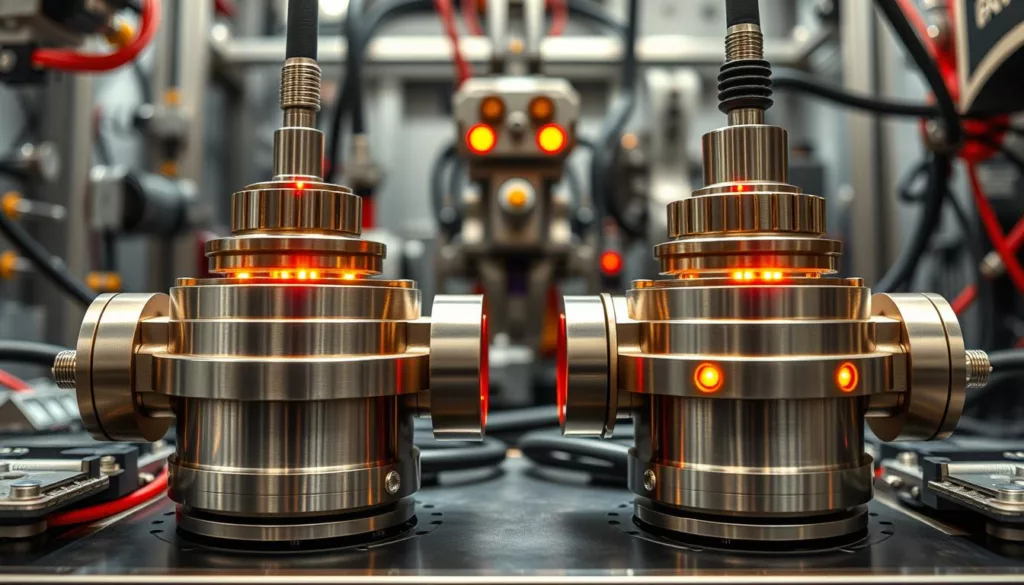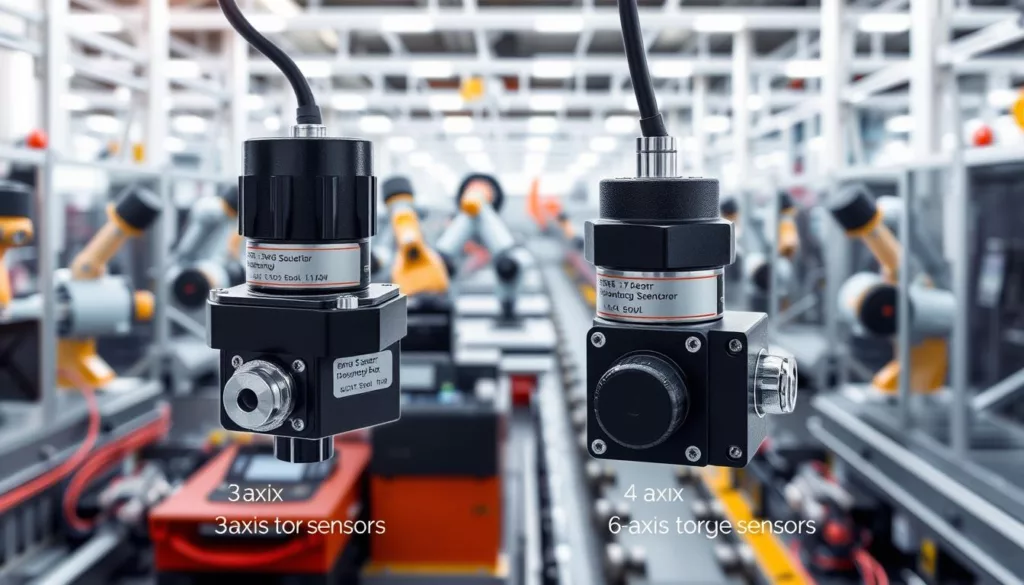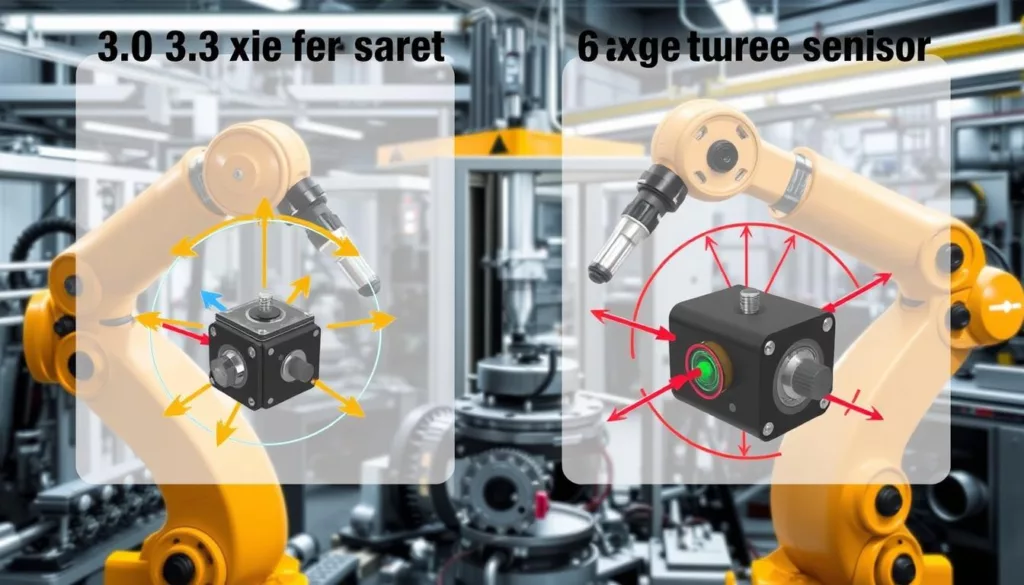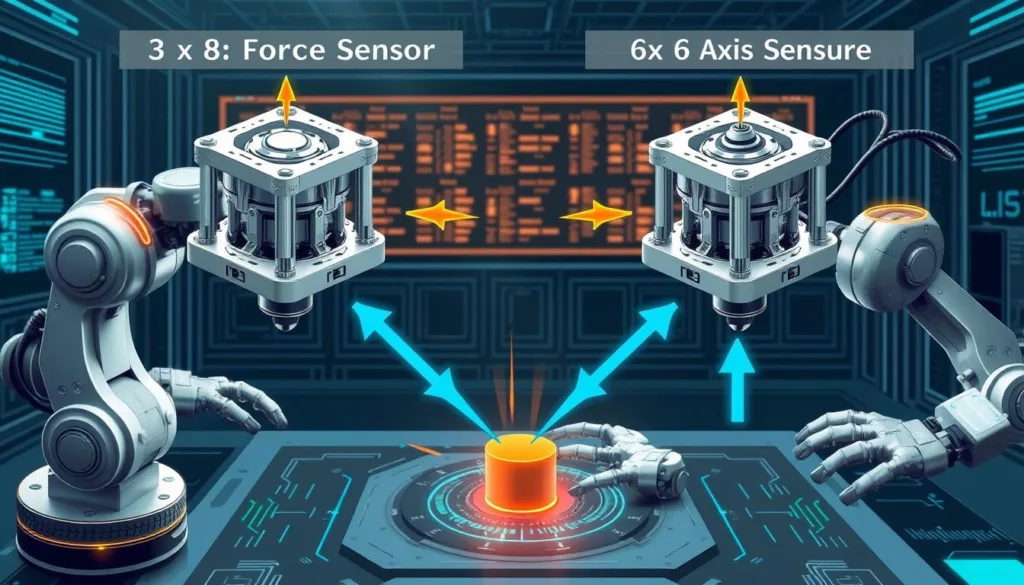In the world of industrial automation, choosing between 3 axis and 6 axis force torque sensors matters a lot. These sensors are key in many fields, like robotics, manufacturing, medical devices, and aerospace. Knowing the differences between them is vital for picking the right one for your needs.
Force torque sensors measure forces and torques on objects or systems. 3 axis sensors track forces and torques in the X, Y, and Z axes. On the other hand, 6 axis sensors can measure in all six degrees of freedom. This means they can handle more complex tasks but come with their own set of challenges.
In this article, we’ll explore the main differences between 3 axis and 6 axis force torque sensors. We’ll look at their design, how they work, and their uses. By the end, you’ll know more about these sensors and be ready to choose the right one for your projects.
Key Takeaways
- 3 axis force torque sensors measure forces and torques along the X, Y, and Z axes, while 6 axis sensors can measure in all six degrees of freedom.
- 6 axis sensors provide more data and control, but need more complex design and calibration.
- Choosing between 3 axis and 6 axis sensors depends on your application’s needs, like precision and control.
- It’s important to weigh the costs, complexity, and performance when picking a force torque sensor.
- New sensor technologies are bringing more innovation to industrial automation and control.
Understanding Force Torque Sensor Fundamentals
Multi-axis load cells and precision force/torque transducers are key in industrial precision. They ensure accurate and reliable data. It’s important to know how they work, their parts, and their design.
Basic Principles of Force Measurement
Force measurement starts with the strain principle. When a force is applied, it slightly changes the sensor’s shape. This change is turned into electrical signals, showing the force’s strength and direction.
Modern sensors use advanced electronics and software. This lets them measure forces and their direction very precisely.
Core Components of Force Torque Sensors
The main parts of force torque sensors are:
- Sensing elements: These are strain gauges or piezoelectric crystals that change mechanical changes into electrical signals.
- Structural members: These are rigid frames or flexures that carry the forces to the sensing elements.
- Amplification and conditioning circuitry: This part boosts and refines the electrical signals from the sensing elements.
- Microprocessors: They handle advanced data processing, calibration, and communication tasks.
Sensor Architecture Overview
The design of precision force/torque transducers is modular. It has different sensing elements placed to measure forces and torques in many axes. This setup lets us understand the complex dynamics in various industrial settings.
Exploring the basics and parts of force torque sensors shows us the tech progress. This progress has led to a new era of precise measurement. It’s helping improve industrial automation and process optimization.
Differences between 3 axis and 6 axis force torque sensors
Choosing between 3 axis and 6 axis force torque sensors is key for robotic and industrial automation. Each type affects how well a system works and what it can measure. Knowing the differences helps pick the best sensor for your needs.
3 axis force torque sensors measure forces in the X, Y, and Z directions. They tell you how strong and in what direction forces are applied. On the other hand, 6 axis force torque sensors measure forces in the X, Y, and Z directions and also the twisting forces around these axes.
| Measurement Axes | 3 Axis Force Torque Sensor | 6 Axis Force Torque Sensor |
|---|---|---|
| Forces | X, Y, Z | X, Y, Z |
| Torque | Not Measured | X, Y, Z |
6 axis sensors are great for places where knowing the twisting forces is important. This includes robotic arms, assembly lines, and medical tools. They help control and improve complex systems by showing how they interact.
3 axis sensors work well in many situations. But, 6 axis sensors give a deeper look at mechanical forces. They are essential in industries needing top-notch industrial automation sensors and precise robot control.
Mechanical Design and Construction Variations
The design and build of precision force/torque transducers and sensors are key to their success. They are carefully made to last in tough environments and give accurate readings. This is done by choosing the right materials and making them with great care.
Structural Components
Force/torque sensors have different parts based on what they measure. 3-axis sensors are simpler, with one main part. But 6-axis sensors are more complex, with many parts to measure all forces and torques. The materials used, like strong alloys or special polymers, help them last longer and work better in different conditions.
Material Considerations
The materials for these sensors are picked for their strength, cost, and how long they last. Things like how well they handle heat and corrosion are important. This makes sure the sensor can handle what it’s meant to do.
Manufacturing Processes
- Precision machining, like CNC, is used to make the detailed parts of force/torque sensors.
- 3D printing is a new way to make complex shapes and designs for sensors.
- Special assembly and calibration steps are done to make sure the sensor works perfectly.
Knowing about the design and build of these sensors helps users choose the right one for their needs. This ensures the sensor works well and lasts a long time.
| Structural Component | 3-Axis Sensor | 6-Axis Sensor |
|---|---|---|
| Sensing Element | Single Force Transducer | Multi-Component Structure |
| Material Selection | High-Strength Alloys | Specialized Polymers |
| Manufacturing Process | Precision Machining | Additive Manufacturing |
Applications in Industrial Automation
3 axis and 6 axis force torque sensors are key in industrial automation. They help control assembly forces and improve precision in many manufacturing steps. These sensors boost efficiency, quality, and productivity in automated settings.
3 axis sensors are vital in robotic assembly lines. They give instant feedback on forces and torques during assembly. This allows for better control and adjustment, leading to fewer defects and higher quality products.
6 axis sensors offer a deeper look at forces and torques. They’re essential for advanced control and monitoring. Used in automated material handling, they ensure safe and precise movement of parts, reducing damage and improving reliability.
| Application | 3 Axis Force Torque Sensors | 6 Axis Force Torque Sensors |
|---|---|---|
| Robotic Assembly | ✓ | ✓ |
| Material Handling | – | ✓ |
| Quality Control | ✓ | ✓ |
| Process Optimization | ✓ | ✓ |
Adding 3 axis and 6 axis sensors to industrial systems has greatly improved assembly control and product quality. As manufacturing needs get more complex, these sensors will be even more important for the future of automation.
Precision and Accuracy Comparisons
In industrial automation and robotics, the precision of force/torque sensors is key. The demand for better performance makes the difference between 3 axis and 6 axis precision force/torque transducers and multi-axis load cells important.
Measurement Resolution
Measurement resolution is a big difference. 6 axis sensors have higher spatial resolution. This means they can monitor forces and torques more precisely in all three dimensions. This is great for tasks that need fine control, like robotic manipulation.
Error Sources and Compensation
Both 3 axis and 6 axis sensors face errors like thermal effects and non-linearity. But, 6 axis sensors use better algorithms to reduce these errors. This makes them more accurate and reliable.
Calibration Requirements
- 3 axis sensors need simpler calibration because they measure along three main axes.
- 6 axis sensors require more detailed calibration to measure accurately in all six degrees of freedom.
Calibrating 6 axis precision force/torque transducers is more complex. But, it leads to better precision and reliability in tough applications.
| Specification | 3 Axis Force/Torque Sensor | 6 Axis Force/Torque Sensor |
|---|---|---|
| Measurement Resolution | Lower spatial resolution | Higher spatial resolution |
| Error Sources | Susceptible to thermal effects, non-linearity, and cross-talk | Advanced compensation algorithms to mitigate errors |
| Calibration Requirements | Simpler calibration process | More detailed calibration procedure |
Choosing between 3 axis and 6 axis multi-axis load cells depends on your application’s needs. You must consider precision, accuracy, and how complex calibration is.
Cost-Benefit Analysis for Different Industries
Choosing between 3-axis and 6-axis force torque sensors is a big decision. It affects how well and accurately industrial systems work. Each type has its own benefits and costs.
6-axis sensors are more advanced but cost more. They offer better precision and can save money in the long run. This makes them worth the extra cost for many industries.
| Industry | Key Considerations | Potential Benefits of 6-axis Force Torque Sensors |
|---|---|---|
| Robotics | Precise force and torque control for delicate operations, complex motion planning, and improved safety | Increased accuracy, better force feedback, and enhanced control for complex robotic tasks |
| Automotive | Accurate measurements for assembly line processes, quality control, and vehicle testing | Improved process control, reduced defects, and enhanced product reliability |
| Aerospace | Reliable force and torque data for structural testing, component evaluation, and maintenance procedures | Enhanced safety, reduced maintenance downtime, and more rigorous quality assurance |
The choice between 3-axis and 6-axis sensors depends on a detailed cost-benefit analysis. It’s important to think about what each industry needs. By weighing the options, companies can improve their processes and achieve success.
Integration Challenges and Solutions
Adding robotic force sensors and assembly force control to current industrial setups can be tough. It involves hardware and software issues. A detailed plan is needed for smooth operation and top performance.
Hardware Integration
Putting robotic force sensors in complex factories needs careful thought. You must consider mounting, cabling, and matching with other gear. A solid sensor setup is key for precise force tracking and reliable control in assembly.
Software Implementation
Software setup for force torque sensors is also critical. You need to set up control algorithms, data handling, and communication protocols. This ensures sensor data is used well for assembly force control. Good software setup boosts process improvement and factory efficiency.
Troubleshooting Common Issues
Even with good planning, problems can pop up when adding robotic force sensors. Issues like signal problems, calibration errors, or software mismatches need a careful fix. Regular checks and upkeep can prevent these issues and keep the system reliable.
By tackling integration hurdles and finding good solutions, makers can smoothly add robotic force sensors and control tech to their work. This leads to better quality, more efficient processes, and a competitive edge.
Performance in Robotic Applications
Robotic force sensors are key to making robots more precise and skilled. They help robots work better with their surroundings. Each sensor type, like 3-axis or 6-axis, has its own benefits.
3-axis sensors measure forces and torques in three directions. They’re great for tasks like picking up objects and putting them together. Their small size and easy setup make them popular in many robots, from factory work to medical use.
6-axis sensors give a full picture of forces and torques in all directions. They measure in six ways (X, Y, Z, roll, pitch, and yaw). This detailed info helps robots do better, like with haptic feedback devices, better planning, and more control for tricky tasks.
| Sensor Type | Key Advantages in Robotic Applications |
|---|---|
| 3-axis robotic force sensors |
|
| 6-axis robotic force sensors |
|
Choosing between 3-axis and 6-axis robotic force sensors depends on the robot’s needs. Knowing each sensor’s strengths helps engineers pick the best one. This choice boosts the robot’s performance and abilities.
Impact on Assembly and Manufacturing Processes
3-axis and 6-axis force torque sensors have changed assembly and manufacturing. They improve quality control and make production more efficient. These sensors are key to bettering many parts of the manufacturing process.
Quality Control Benefits
Force torque sensors give exact force and torque data in real-time. This helps spot problems with fit, alignment, and quality. They let manufacturers fix issues quickly, cutting down on waste and rework.
Production Efficiency Gains
Assembly force control with 3-axis and 6-axis sensors boosts production efficiency. Automated systems adjust forces for tasks like clamping and screw tightening. This ensures quality and saves time, leading to faster production and better equipment use in industrial automation.
| Metric | 3-Axis Force Torque Sensor | 6-Axis Force Torque Sensor |
|---|---|---|
| Measurement Axes | 3 (X, Y, Z) | 6 (X, Y, Z, Rx, Ry, Rz) |
| Precision and Accuracy | High in linear force measurement | Exceptional in both linear and rotational force/torque measurement |
| Application Versatility | Suitable for linear assembly tasks | Ideal for complex, multi-axis assembly operations |
Using advanced force torque sensors, manufacturers can make their assembly better. They improve product quality and boost efficiency. This helps their profits a lot.
Future Trends and Technological Advancements
The need for precise force and torque measurements is growing fast. This is driving new advancements in force torque sensor technology. Miniaturization and better sensitivity are key, making these sensors fit into smaller, more responsive biomechanics research instruments and haptic feedback devices. The trend towards working well with AI and IoT systems is also big, opening up new ways to analyze data and control machines in real-time.
Another exciting area is sensor fusion. This combines force torque sensors with IMUs and vision systems. It makes force and torque data more accurate and reliable. This is great for detailed analysis and smart decisions in fields like surgical robotics and advanced manufacturing.
XJCSENSOR is leading the way in innovation, using their knowledge to create top-notch force torque sensors. They focus on quality, customization, and keeping up with new tech. XJCSENSOR is set to influence the future of this field and help industries worldwide grow.





